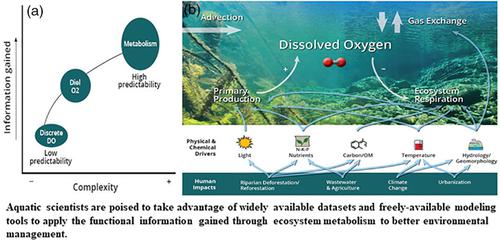当前位置:
X-MOL 学术
›
WIREs Water
›
论文详情
Our official English website, www.x-mol.net, welcomes your feedback! (Note: you will need to create a separate account there.)
Aquatic ecosystem metabolism as a tool in environmental management
WIREs Water ( IF 8.2 ) Pub Date : 2021-03-28 , DOI: 10.1002/wat2.1521 Kathi Jo Jankowski 1 , Francine H. Mejia 2 , Joanna R. Blaszczak 3 , Gordon W. Holtgrieve 4
WIREs Water ( IF 8.2 ) Pub Date : 2021-03-28 , DOI: 10.1002/wat2.1521 Kathi Jo Jankowski 1 , Francine H. Mejia 2 , Joanna R. Blaszczak 3 , Gordon W. Holtgrieve 4
Affiliation

|
Recent advances in high-frequency environmental sensing and statistical approaches have greatly expanded the breadth of knowledge regarding aquatic ecosystem metabolism—the measurement and interpretation of gross primary productivity (GPP) and ecosystem respiration (ER). Aquatic scientists are poised to take advantage of widely available datasets and freely-available modeling tools to apply functional information gained through ecosystem metabolism to help inform environmental management. Historically, several logistical and conceptual factors have limited the widespread application of metabolism in management settings. Benefitting from new instrumental and modeling tools, it is now relatively straightforward to extend routine monitoring of dissolved oxygen (DO) to dynamic measures of aquatic ecosystem function (GPP and ER) and key physical processes such as gas exchange with the atmosphere (G). We review the current approaches for using DO data in environmental management with a focus on the United States, but briefly describe management frameworks in Europe and Canada. We highlight new applications of diel DO data and metabolism in regulatory settings and explore how they can be applied to managing and monitoring ecosystems. We then review existing data types and provide a short guide for implementing field measurements and modeling of ecosystem metabolic processes using currently available tools. Finally, we discuss research needed to overcome current conceptual limitations of applying metabolism in management settings. Despite challenges associated with modeling metabolism in rivers and lakes, rapid developments in this field have moved us closer to utilizing real-time estimates of GPP, ER, and G to improve the assessment and management of environmental change.
中文翻译:

作为环境管理工具的水生生态系统代谢
高频环境传感和统计方法的最新进展极大地扩展了有关水生生态系统代谢的知识广度 - 总初级生产力 (GPP) 和生态系统呼吸 (ER) 的测量和解释。水生科学家准备利用广泛可用的数据集和免费可用的建模工具来应用通过生态系统代谢获得的功能信息,以帮助为环境管理提供信息。从历史上看,一些后勤和概念因素限制了新陈代谢在管理环境中的广泛应用。受益于新的仪器和建模工具,现在,将溶解氧 (DO) 的常规监测扩展到水生生态系统功能的动态测量(GPP 和 ER)和关键物理过程(如与大气的气体交换 (G))相对简单。我们回顾了当前在环境管理中使用 DO 数据的方法,重点是美国,但简要描述了欧洲和加拿大的管理框架。我们重点介绍了 diel DO 数据和代谢在监管环境中的新应用,并探索如何将它们应用于管理和监测生态系统。然后,我们审查现有的数据类型,并提供一个简短的指南,以使用当前可用的工具实施生态系统代谢过程的现场测量和建模。最后,我们讨论了克服当前在管理环境中应用新陈代谢的概念限制所需的研究。尽管与河流和湖泊中的代谢建模相关的挑战,该领域的快速发展使我们更接近于利用 GPP、ER 和 G 的实时估计来改进环境变化的评估和管理。
更新日期:2021-06-04
中文翻译:

作为环境管理工具的水生生态系统代谢
高频环境传感和统计方法的最新进展极大地扩展了有关水生生态系统代谢的知识广度 - 总初级生产力 (GPP) 和生态系统呼吸 (ER) 的测量和解释。水生科学家准备利用广泛可用的数据集和免费可用的建模工具来应用通过生态系统代谢获得的功能信息,以帮助为环境管理提供信息。从历史上看,一些后勤和概念因素限制了新陈代谢在管理环境中的广泛应用。受益于新的仪器和建模工具,现在,将溶解氧 (DO) 的常规监测扩展到水生生态系统功能的动态测量(GPP 和 ER)和关键物理过程(如与大气的气体交换 (G))相对简单。我们回顾了当前在环境管理中使用 DO 数据的方法,重点是美国,但简要描述了欧洲和加拿大的管理框架。我们重点介绍了 diel DO 数据和代谢在监管环境中的新应用,并探索如何将它们应用于管理和监测生态系统。然后,我们审查现有的数据类型,并提供一个简短的指南,以使用当前可用的工具实施生态系统代谢过程的现场测量和建模。最后,我们讨论了克服当前在管理环境中应用新陈代谢的概念限制所需的研究。尽管与河流和湖泊中的代谢建模相关的挑战,该领域的快速发展使我们更接近于利用 GPP、ER 和 G 的实时估计来改进环境变化的评估和管理。



























 京公网安备 11010802027423号
京公网安备 11010802027423号